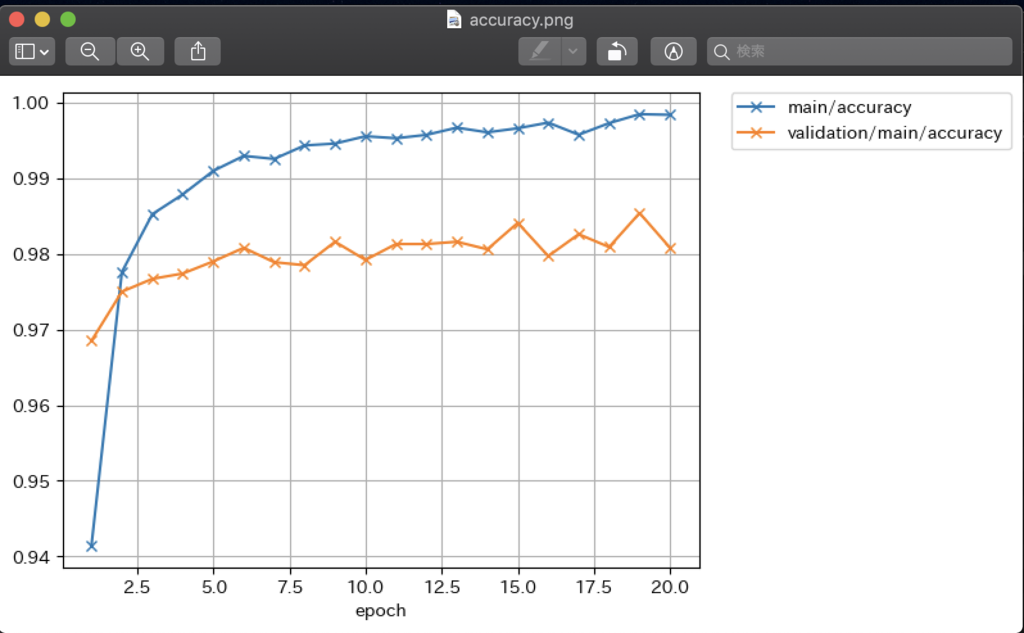Chainerとは深層学習のPythonのライブラリです。
Chainerのポイントはパワフルで、柔軟性があって、直感的と3つのポイントがあります。
ある勉強会でも、Chainerはわかりやすいとおっしゃっている方がいたのを思い出します。
それだけでなく、日本の企業Preferred Network社が開発したオープンソースであることでしょう。
日本人として、多少は贔屓したいところ。
上記サイトのQuickStartにある内容を試してみることにします。
※今回は、本当にQuickStartするだけです。
wget https://github.com/chainer/chainer/archive/v5.1.0.tar.gz tar xzf v5.1.0.tar.gz python chainer-5.1.0/examples/mnist/train_mnist.py
Macで試すには
pip install chainer
ライブラリインストールだけではなく、wgetコマンドをインストールしておく必要があります。
Homebrewを使って
と叩けばOKです。
Homebrewもない方はHomebrewをインストールしてください
train_mnist.pyより、手書き数字の深層学習のソースが実行されます。
また、githubのソースが取得されるため、サンプルやらソースの一式がダウンロードされています。

train_mnist.pyを実行すると以下のようなプロットデータも出力されてますね。

実行されたのは、下記のコード。
chainer/train_mnist.py at master · chainer/chainer · GitHub
#!/usr/bin/env python import argparse import chainer import chainer.functions as F import chainer.links as L from chainer import training from chainer.training import extensions # Network definition class MLP(chainer.Chain): def __init__(self, n_units, n_out): super(MLP, self).__init__() with self.init_scope(): # the size of the inputs to each layer will be inferred self.l1 = L.Linear(None, n_units) # n_in -> n_units self.l2 = L.Linear(None, n_units) # n_units -> n_units self.l3 = L.Linear(None, n_out) # n_units -> n_out def forward(self, x): h1 = F.relu(self.l1(x)) h2 = F.relu(self.l2(h1)) return self.l3(h2) def main(): parser = argparse.ArgumentParser(description='Chainer example: MNIST') parser.add_argument('--batchsize', '-b', type=int, default=100, help='Number of images in each mini-batch') parser.add_argument('--epoch', '-e', type=int, default=20, help='Number of sweeps over the dataset to train') parser.add_argument('--frequency', '-f', type=int, default=-1, help='Frequency of taking a snapshot') parser.add_argument('--gpu', '-g', type=int, default=-1, help='GPU ID (negative value indicates CPU)') parser.add_argument('--out', '-o', default='result', help='Directory to output the result') parser.add_argument('--resume', '-r', default='', help='Resume the training from snapshot') parser.add_argument('--unit', '-u', type=int, default=1000, help='Number of units') parser.add_argument('--noplot', dest='plot', action='store_false', help='Disable PlotReport extension') args = parser.parse_args() print('GPU: {}'.format(args.gpu)) print('# unit: {}'.format(args.unit)) print('# Minibatch-size: {}'.format(args.batchsize)) print('# epoch: {}'.format(args.epoch)) print('') # Set up a neural network to train # Classifier reports softmax cross entropy loss and accuracy at every # iteration, which will be used by the PrintReport extension below. model = L.Classifier(MLP(args.unit, 10)) if args.gpu >= 0: # Make a specified GPU current chainer.backends.cuda.get_device_from_id(args.gpu).use() model.to_gpu() # Copy the model to the GPU # Setup an optimizer optimizer = chainer.optimizers.Adam() optimizer.setup(model) # Load the MNIST dataset train, test = chainer.datasets.get_mnist() train_iter = chainer.iterators.SerialIterator(train, args.batchsize) test_iter = chainer.iterators.SerialIterator(test, args.batchsize, repeat=False, shuffle=False) # Set up a trainer updater = training.updaters.StandardUpdater( train_iter, optimizer, device=args.gpu) trainer = training.Trainer(updater, (args.epoch, 'epoch'), out=args.out) # Evaluate the model with the test dataset for each epoch trainer.extend(extensions.Evaluator(test_iter, model, device=args.gpu)) # Dump a computational graph from 'loss' variable at the first iteration # The "main" refers to the target link of the "main" optimizer. trainer.extend(extensions.dump_graph('main/loss')) # Take a snapshot for each specified epoch frequency = args.epoch if args.frequency == -1 else max(1, args.frequency) trainer.extend(extensions.snapshot(), trigger=(frequency, 'epoch')) # Write a log of evaluation statistics for each epoch trainer.extend(extensions.LogReport()) # Save two plot images to the result dir if args.plot and extensions.PlotReport.available(): trainer.extend( extensions.PlotReport(['main/loss', 'validation/main/loss'], 'epoch', file_name='loss.png')) trainer.extend( extensions.PlotReport( ['main/accuracy', 'validation/main/accuracy'], 'epoch', file_name='accuracy.png')) # Print selected entries of the log to stdout # Here "main" refers to the target link of the "main" optimizer again, and # "validation" refers to the default name of the Evaluator extension. # Entries other than 'epoch' are reported by the Classifier link, called by # either the updater or the evaluator. trainer.extend(extensions.PrintReport( ['epoch', 'main/loss', 'validation/main/loss', 'main/accuracy', 'validation/main/accuracy', 'elapsed_time'])) # Print a progress bar to stdout trainer.extend(extensions.ProgressBar()) if args.resume: # Resume from a snapshot chainer.serializers.load_npz(args.resume, trainer) # Run the training trainer.run() if __name__ == '__main__': main()
サンプルだから、というのもあるかも知れませんが、MLPクラスで行われている処理などは、Pythonにしては、手堅い使い方な感じもしました。
もう少し掘り下げてみたいと思います。